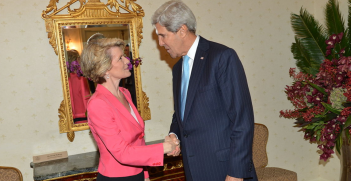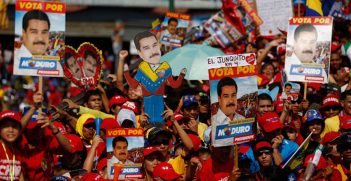New Era for Australia in Latin America

The Peru-Australia free trade agreement marks a new turning point in Australia’s broader relationship with the Latin American region. Australia should seize the opportunity to act as a major conduit between both sides of the Pacific.
On the 12th of February 2018, Australia welcomed its distant pacific neighbour to Canberra for the signing of the Peru-Australia Free Trade Agreement (PAFTA). Although it may not attract many headlines, finalising the PAFTA should be recognised as one of many recent milestones for Australia to continue improve economic and cultural ties with Latin America, a region that for decades has been overlooked by Australian foreign policy-makers.
Despite a long period of diplomatic indifference, the PAFTA is representative of a significant shift in Australia’s stance towards not only Peru, but Latin America as a whole. By committing to the agreement, Australia has demonstrated that it is serious about expanding its relations with the continent. As such, Australia is increasingly in a position to benefit from the emergence of Latin American nations as economic players in the Pacific. Australia acts as a conduit for trade between its economic partners in Asia and the newcomers from across the ocean.
An overview of PAFTA
The PAFTA was announced by Prime Minister Malcolm Turnbull in Vietnam at the 2017 Asia-Pacific Economic Cooperation Summit. Turnbull stressed that “the region cannot close the door to the flow of goods, services, capital and ideas.” For Australia, what lies behind this door looks promising. In 2016, Australia’s bilateral trade in goods and services with Peru totalled some AUD$ 590 million. This figure marked a 51.2 per cent increase in trade from 2015. In light of the PAFTA’s broad range of outcomes, this trend can reasonably be expected to continue.
Highlights of the agreement include the opening of Peruvian markets to Australian dairy farmers and the immediate removal of duty on a variety of Australian products. This ranges from wine and wheat to pharmaceuticals and medical devices. Additionally, within five years Peru will eliminate tariffs (up to 17 per cent) on Australian beef, allowing Australian exporters to compete with their US counterparts. Educational links between the nations are also set to be strengthened, with the recognition of Australian degrees in Peru.
The PAFTA is good news for the Andean nation. Minister for Trade and Tourism, Enrique Ferreyros, stated that it was his nation’s “most ambitious so far.” He hailed the significance of the PAFTA for Peru in gaining access to “one of the most important markets in the Asia-Pacific region.” This access translates to an estimated doubling of Peruvian agro-exporter output to Australian markets.
Peru was an obvious choice for a new long-term partner in Latin America. Experiencing a huge expansion during the 2000s commodities boom, Peru’s economy has since stabilised and continues to grow steadily. Unlike other boom and bust economies, the wealth that Peru amassed was subsequently filtered back into broad economic reforms or used to bolster its foreign wealth reserves.
Since then, vast portions of the country have been lifted out of poverty. Between 2005 and 2010, the rate of poverty in Peru fell sharply by 18.7 per cent. Crucially, once the boom had subsided, this trend continued with poverty rates increasing for the first time only last year after almost two decades of improvement. Peru’s government has begun to extend its influence further afield, securing free trade agreements with the European Union (EU), the United States (US), and China, among others. The country is now known as one of the four ‘Pacific Pumas’: the collective of economically blossoming Latin American countries that have cooperated to sign the Pacific Alliance, a landmark trade pact which seeks to catapult these economies into the Asian century.
It is plain to see why Australia would seek to capitalise on Peru’s good fortunes, as it has done with its neighbours in the Asia-Pacific region. However, Australia has traditionally been hesitant to establish economic ties with Latin American countries. To properly appreciate the importance of the PAFTA, particular regard should be paid to the broader historical context of Australian-Latin American relations.
From wilful ignorance to a free trade agreement: the case of Chile
The case of Chile reveals a series of stuttered attempts at trade, exacerbated by the country’s 20th century instability. This contributed to the long-prevailing attitude that Latin America was closed for business, a key determinant in restricting cross-pacific cooperation.
This belief was not the sole factor at play, and there existed very real barriers to trade. Australia and Latin America have shared a degree of comparative advantage in commodities. Geopolitical alliances, slow trade liberalisation and the vast geographic distances between ports have also had a hand in limiting exchanges. However, it was ultimately the ‘policy of benign neglect’ that was decisive in limiting the scope of Australian trade with the continent even once these practical difficulties had been done away with.
Australia’s relationship with Chile saw to an abrupt end due to the military coup that overthrew the Allende government in 1973. So damaging was this experience that Australia and Chile did not regain trade volumes equivalent to that of the late 1960s. It contributed to Latin America being regarded as too remote, too corrupt, and not worth considering for trade relations.
Only during the 1990s did voices within Australia begin to raise concern at the lack of attention that was being afforded to Latin America. Slowly, Australia started to rebuild its trust in Latin America. Domestically, a watershed moment in the process of mending ties with the region was the establishment of the Council on Australia Latin America Relations in 2001. Real diplomatic strides were taken following the visit of President Ricardo Lagos in 2003.
However, it was not until 2008 that Australia signed its free trade agreement with Chile. Even so, this was two years after Chile achieved the highest nominal GDP in Latin America. It has also taken another decade for a second agreement to be realised, suggesting how difficult it was to undo the damage caused by Australia’s indifference towards Latin America.
In contrast to the Chilean case, the PAFTA suggests that Australia has moved beyond testing the waters with Latin America. Concurrently to negotiating the PAFTA, Australia signed the TPP and continued working to join the Pacific Alliance. It is precisely through this paradigm that the PAFTA’s importance can be understood: not as another tentative step towards trade with the broader Pacific region, but rather a deliberate move to reinforce Australia’s new role as a stepping stone for trade between Asia and Latin America.
The rethinking of Australia’s Asia-centric orientation in the Pacific puts Australia in a unique position. If it aligns itself correctly, Australia should seize the chance to act as the “connecting rod” between both sides of the Pacific, particularly if it takes part in the Pacific Alliance. Given that this is now within reach, Australia appears ready to embrace its new role in the Pacific and gain maximum benefit from its neighbours, both near and far.
Jake Kite recently finished his Bachelor of Laws/Arts at La Trobe University, where he has since begun his Honours thesis. His primary areas of research are paradiplomacy, neo-regionalism and Catalan identity.
This is an edited extract of an article titled “Wide, Wide Pacific: The Australia – Peru F TA signals a new era for Australia in Latin America” published in Volume 11, Issue 2 of Quarterly Access, the national publication of the youth networks of the AIIA.
This article is published under a Creative Commons Licence and may be republished with attribution.





